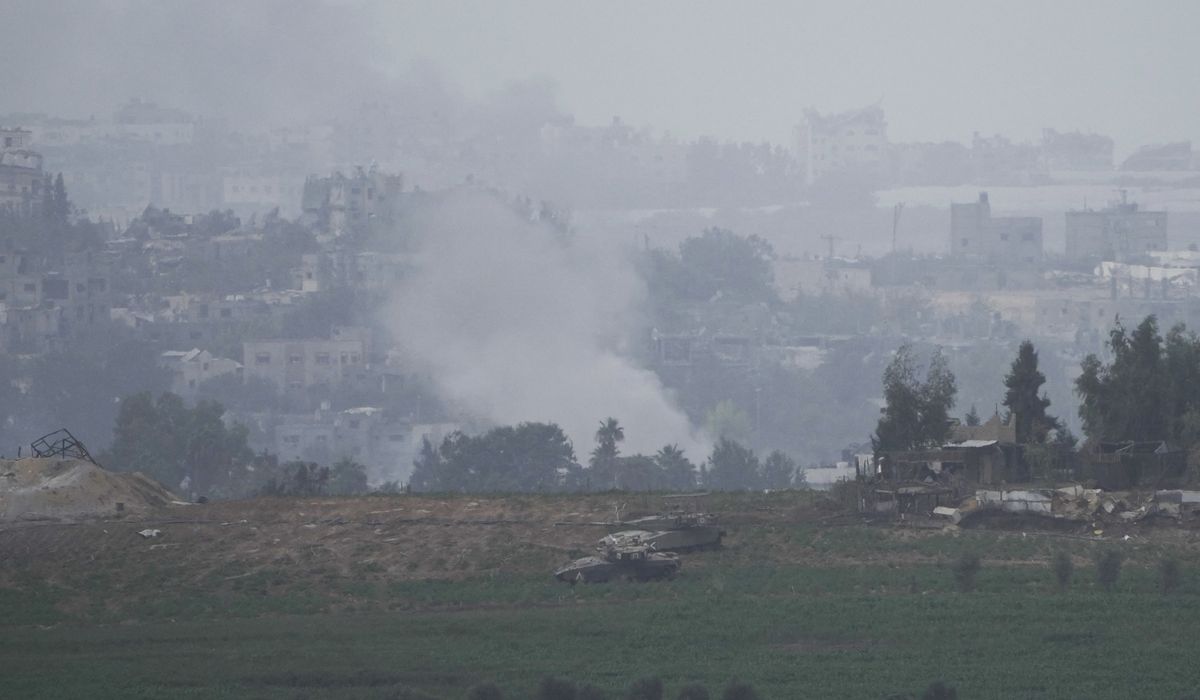SDEROT, Israel | Israeli troops are expanding their operations in northern Gaza as the country entered the fourth week of its war against Hamas.
With Israeli Prime Minister Benjamin Netanyahu promising that Israeli Defense Forces have entered the “second stage” of a retaliatory campaign against Hamas militants who staged a terror rampage here on Oct. 7, the fighting at the northern end of the Palestinian enclave could prove some of the most critical — and bloodiest — fighting to date.
Tanks and armored vehicles, along with artillery, drones and aircraft, engaged Palestinian fighters throughout the last several days of increased fighting.
At one point the IDF said that soldiers operating near the Erez crossing, which used to be a border control post for Gazans entering Israel, noticed terrorists “exiting the shaft of a tunnel.” Israeli soldiers “confronted the terrorists, killing and injuring them,” the IDF statement said. The firefight near Erez was one of many clashes on Sunday.
Israel also engaged Hamas gunmen near Zikim, a community that sits on dunes above a beach in Israel, next to the border fence in Gaza.
Zikim and Erez were among the locations that Hamas attacked on Oct. 7, when terrorists stormed the border at 29 locations and killed 1,400 people — overwhelmingly civilians. Israel is still reeling from the attack.
The IDF says they have identified 230 people kidnapped by Hamas being held in Gaza. The number continues to grow as Israel identifies more missing people. Hamas has released only four people since the attacks, two American women and two elderly Israeli women. Israeli Minister of Defense Yoav Gallant, who has vowed a strong, uncompromising assault on Hamas leaders and fighters, on Sunday met with some of the families of Israelis being held in Gaza.
“It was important for me to meet and hear from you,” he said. “Returning the hostages and tracking missing Israelis is a mission of utmost importance.”
Mr. Gallant said he had “two goals: returning those who were kidnapped and winning this war. All the rest is less important right now,” he said. “… You have all seen who Hamas is – there is nothing more important than returning the hostages and eradicating Hamas.” He said that the current ground offensive is linked to efforts to return the hostages.
“If Hamas does not feel military pressure, nothing will move forward,” Mr. Gallant said. “They seek the collapse of Israeli society from within and are using the hostages in a brutal manner. The military operation is intended, among other things, to increase the chance of returning our people.”
Silent streets In the city of Sderot on the border of Gaza, the once-bustling streets are now silent. The city is one of almost 100 communities that have been evacuated in Israel.
After Hamas attacked, Israel was forced to evacuate 25 border communities. Most of these are small kibbutzim that date from the 1950s. Several suffered a horrendous death toll in the attack, with dozens killed and kidnapped in some communities.
Sderot, a city of 30,000, has suffered from Hamas rocket fire for decades. It was always resilient and in recent years new apartment buildings and playgrounds mushroomed in the city. Israel’s Iron Dome defense system and a network of sirens and public warning systems helped people avoid rocket fire. But Oct. 7 marked something new for Sderot residents. Terrorists entered the city in white pickup trucks. They massacred people at bus stops, gunned down drivers, and attacked the police station. The result: a city is almost deserted.
On a recent night, one lone man sat on the roof of a house overlooking Gaza. Nearby soldiers patrolled several small hillocks. New buildings under construction, the cement freshly poured, sat empty, dark and ghostly. In the distance lay Gaza, just a mile away.
The buzzing of drones could be heard overhead. Above the clanging of armored vehicles churning up sand, dust from the movement clogged the air. In the distance, the endless reverberations of artillery fire and airstrikes pounded the ground. Flashes of light, several miles away, burst and illuminated the clouds. Israel carried out airstrikes against 450 targets in Gaza, the IDF said on Sunday. These includedoperational command centers, observation posts, and anti-tank missile launch posts.
“As part of the expansion of ground activities, combined combat forces struck terrorist cells that attempted to attack the forces and terrorist cells that planned to carry out anti-tank missile launches,” the IDF said. “In addition, the ground forces directed IDF aircraft toward terror targets.” With Hamas, the U.S. and the world waiting on the Netanyahu government’s next move, IDF spokesman Rear Admiral Daniel Hagari said late Sunday that Israel has expanded operations into the Gaza Strip with the entry of ground troops. This followed two raids last week by armored vehicles that prepared the ground for the current offensive.
“The ground operations in the northern Gaza Strip continue. We are progressing through the stages of the war according to plan. We are gradually expanding the ground activity and the scope of our forces in the Gaza Strip,” said Rear Adm. Hagari. Israeli officials are feeling the outside pressure to minimize civilian casualties and avoid a humanitarian disaster as they plan steps to eliminate Hamas as a fighting force and destroy its power base in the dense Palestinian enclave.
President Biden, in a phone call with Mr. Netanyahu Sunday, again emphasized the need for Israeli forces to proceed “in a manner consistent with international humanitarian law that prioritizes the protection of civilians,” the White House said in a press statement.
“We will do everything we can from the air, sea and land to ensure the safety of our forces and achieve the goals of the war,” said Rear Adm. Hagari, but the security, logistical, political and moral questions are almost certain to deepen as the operation proceeds.
𝗖𝗿𝗲𝗱𝗶𝘁𝘀, 𝗖𝗼𝗽𝘆𝗿𝗶𝗴𝗵𝘁 & 𝗖𝗼𝘂𝗿𝘁𝗲𝘀𝘆: www.washingtontimes.com
𝗙𝗼𝗿 𝗮𝗻𝘆 𝗰𝗼𝗺𝗽𝗹𝗮𝗶𝗻𝘁𝘀 𝗿𝗲𝗴𝗮𝗿𝗱𝗶𝗻𝗴 𝗗𝗠𝗖𝗔,
𝗣𝗹𝗲𝗮𝘀𝗲 𝘀𝗲𝗻𝗱 𝘂𝘀 𝗮𝗻 𝗲𝗺𝗮𝗶𝗹 𝗮𝘁 [email protected]



